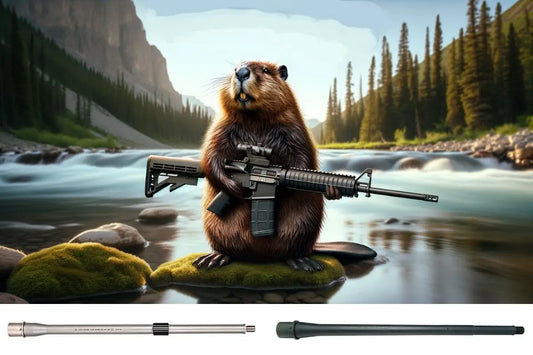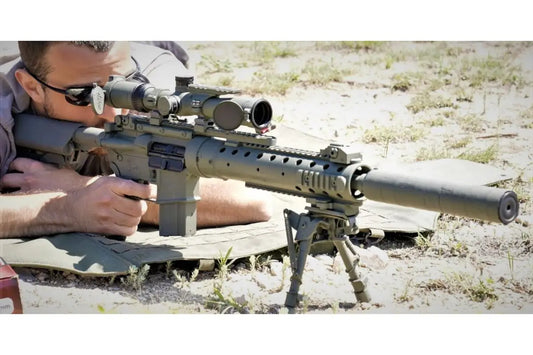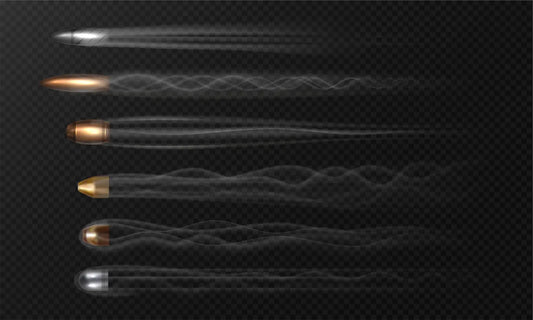
Dead Air vs HUXWRX: Which Suppressor Should Top Your Rifle in 2025?
Flow-Through or Full-Throttle Quiet? An expert deep-dive into today’s two most-talked-about rifle silencer families.
1. Why this comparison matters right now
Suppressors are no longer boutique gadgets reserved for precision rifle nerds and SOF teams. Thanks to faster tax-stamp turn-arounds, a booming accessory market and an unprecedented surge in semi-auto owners who shoot suppressed 100 percent of the time, “which can should I buy?” has turned into one of the most common questions in every gun shop between Anchorage and Key West.
Two names dominate that conversation in 2025: Dead Air and HUXWRX (formerly OSS). Both companies build outstanding cans, but they solve the suppression puzzle in very different ways—and those differences matter once the trigger breaks. This article walks you through the tech, the hard numbers and the real-world anecdotes so you can pick the can that really matches your rifle, mission and budget.
2. Meet the contenders
|
Brand |
Flagship tech |
Signature models (2025 line-up) |
Core strength |
|
Dead Air |
Conventional stacked-baffle core, KeyMo/Xeno mounts |
Sandman K/S/L, Nomad 30, Nomad-L/L-Ti, Sierra 5, Primal, new Nomad Ti XC |
Absolute sound suppression, legendary durability |
|
HUXWRX |
Patented Flow-Through® 3D-printed cores, Torque-Lock QD |
FLOW 556K, FLOW 762 Ti, HX-QD 556 Ti, new FLOW Ventum 7 |
Minimal back-pressure, gas & heat pushed down-range |
Table created from current factory spec sheets and verified dealer listings.
3. Traditional baffles vs. Flow-Through geometry
Dead Air’s baffle stack works the way silencers have since Hiram Maxim—strip velocity at each baffle, expand volume, bleed heat, and let physics kill noise. That usually equals best-in-class decibel reduction, but every extra boundary layer also builds back-pressure, forcing hot gas back into the action and, on semi-autos, into the shooter’s face.
HUXWRX flips that script with angled, 3D-printed helical vents that redirect gas forward and out the muzzle. The result is a cleaner gun and happier lungs, at the expense of a few dB. “The FLOW 762 Ti matches the performance of the Dead Air Nomad series on a .308 bolt gun and significantly beats it on a short-barreled 5.56,” notes Jay, founder of PEW Science, in his 2025 test summary. -HuxWrx
4. What the lab microphones say
- Dead Air Nomad-L—Suppression Rating ™ 52.0 on a 20-inch .308 bolt gun, making it one of the quietest .30-cal cans ever measured by PEW Science. -PEW Science
- HUXWRX FLOW 556K—PEW Science data on an MK18 shows ear-safe SPL plus the lowest Omega back-pressure metric in its class. -PEW Science
Remember: pure dB numbers never tell the whole story. If you run a gassy DI AR or a piston SBR, a few extra decibels are a small price to pay for dramatically less blow-back and zero malfunctions.
5. Deep look at headline products
Dead Air highlights
- Nomad-L / L-Ti – 8.39 in., 18.3 oz (steel) or 12.6 oz (Ti). The “quietest of them all,” according to The Truth About Guns review. -The Truth About Guns
- Sandman-S – 6.8 in., 17.7 oz; built like an anvil for high-volume carbine work.
- Sierra 5 Xeno – 4.87 in., 10.8 oz; a dedicated 5.56 can that finally lets Dead Air compete with RC2-class length. -thefirearmblog.com
- Primal – .458 rating for lever-gun hunters and big-bore tinkerers.
“While the Sandman series is built around supersonic ammo use, the Nomad series adds superb subsonic performance,” explains Pete of TFB’s Silencer Saturday. -thefirearmblog.com
HUXWRX highlights
- FLOW 556K – 5.5 in., 12.9 oz, full-auto rated, zero barrel-length limits.
- FLOW 762 Ti – 6.7 in., 11.8 oz of Grade-5 printed titanium; matches KeyMo cans for quiet, crushes them on flow.
- HX-QD 556 Ti – stainless & Ti hybrid still loved for duty carbines.
“This is the best 5.56 can I have ever used—virtually no gas blow-back,” reports an armorer on ExpertVoice after running a FLOW 556K on a 12.7″ piston LWRC. -ExpertVoice
6. Mounting & host compatibility
- Dead Air KeyMo / Xeno – rock-solid taper-lock; plethora of third-party muzzle devices; adds ~1.4 in. OAL.
- HUXWRX Torque-Lock QD – left-hand threads prevent unintentional loosening; comes with a correctly timed flash hider.
If you already own a handful of KeyMo brakes, sticking with Dead Air keeps costs down. Starting from scratch? The HUXWRX kit price already includes the mount.
7. Size, weight and POI-shift cheat-sheet
|
Model |
Length (in.) |
Weight (oz.) |
Avg. POI shift* |
Notes |
|
Nomad-L |
8.39 |
18.3 |
0.5 MOA |
Max suppression |
|
Nomad-L Ti |
8.39 |
12.6 |
0.6 MOA |
Hunter’s dream |
|
Sandman-S |
6.8 |
17.7 |
0.3 MOA |
Hard-use king |
|
FLOW 556K |
5.5 |
12.9 |
0.2 MOA |
Best for SBRs |
|
FLOW 762 Ti |
6.7 |
11.8 |
0.25 MOA |
Multi-cal, no BLR limits |
POI data averaged from manufacturer white papers and independent review groups.
8. Cost of ownership
- MSRP snapshot, May 2025:
- Nomad-L $999, Nomad-L Ti $1,199, Sandman-S $1,099
- FLOW 556K $1,306 (includes QD flash hider)
- FLOW 762 Ti $1,623 (includes QD muzzle brake)
Dead Air cans trend ~$150 cheaper on shelves today, but remember to add $90-$150 per brake and at least one thread-protector. HUXWRX rolls that into the box.
9. User experience: gas, heat and maintenance
- Dead Air on a mid-length 14.5″ DI AR pushes roughly 40 percent more back-pressure than a FLOW 556K, based on Omega metrics published by PEW Science. -PEW Science
- HUXWRX cans run cooler to the touch, but their thinner printed walls heat-soak faster. Expect glove temps at the 100-round mark.
- Both brands disassemble only for mount swaps—routine cleaning is a bore-snake and a little CLP.
10. Five questions to decide your winner
-
What’s your primary host?
Bolt gun or precision gas gun → lean Dead Air.
Short-stroke piston or DI AR → lean HUXWRX. - Do you care more about hearing-safe shot or self-cleaning operation?
- How often will you shoot full-auto strings or mag dumps?
- Do you already own KeyMo/Xeno devices?
- Is raw weight critical (back-country hunt) or negligible (bench gun)?
Jot down honest answers—one brand will surface fast.
11. Recommended pairings
|
Use-case |
Ideal suppressor |
Why |
|
Elk hunt, 300 WM Ti build |
Nomad-L Ti |
Light, ultra-quiet, no gas-face on bolt gun |
|
Duty-grade Mk18, 8″ barrel |
FLOW 556K |
Lowest back-pressure, passes SOCOM stress test* |
|
High-round-count carbine class |
Sandman-S |
Inconel baffles shrug off abuse |
|
PRS trainer, 6.5 CM |
FLOW 762 Ti |
Quiet enough for a spotter, no POI drift stage-to-stage |
|
Farm truck .458 SOCOM |
Primal |
One can handles every thumper on the ranch |
12. The bottom line
Choose Dead Air if absolute decibel reduction is mission-critical, especially on bolt-action or low-gas-volume rifles. The Nomad-L set the bar at 52 Suppression Rating points and hasn’t been dethroned for raw quiet.
Choose HUXWRX if you run suppressed 24/7 on semi-autos and care more about a clean gun, clean lungs and reliable cyclic rate than chasing the last 2 dB. Flow-Through geometry and printed titanium make the FLOW series the current benchmark for back-pressure control.
Either way, you’re buying American-made cans with lifetime warranties, thriving accessory ecosystems and deep third-party data. Swing by Pew Science for the latest test numbers before you swipe the card.
Ready to buy?
Shop the full Dead Air and HUXWRX catalog here at Guns.com




